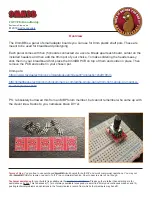
LBP2 User Guide
Document No: 50306-001
Rev G 3/12/2020
Page 77
Where :
drd
r
Z
r
E
drd
r
Z
r
E
r
)
,
,
(
)
,
,
(
2
2
Where:
r is the distance from the centroid
)
,
(
y
x
is the azimuth angle
and where the first moments give the coordinates of the
centroid
dxdy
z
y
x
E
dxdy
z
y
x
xE
x
)
,
,
(
)
,
,
(
dxdy
z
y
x
E
dxdy
z
y
x
yE
y
)
,
,
(
)
,
,
(
Only beam propagation factors based on second moment beam widths/diameters
and divergence angles derived from the second moments of the energy density
distribution function, will allow one to predict how a beam will propagate. Other
definitions of the beam widths/diameters and divergence angles may be used, but
they must be shown to be equivalent to the second moment definitions for
computing the correct beam propagation.
To make an accurate measurement of the beam widths establish an aperture for
the beam inside a Manual or Auto Aperture. The aperture must be approximately
2x the size of the beam. The Auto Aperture feature will automatically provide such
an aperture under most operating conditions. It can be used in combination with a
Manual Aperture if needed. If the beam size is already equal to about 1/2 the
beam display window, then drawing an aperture may not be necessary. In such an
event, be sure to center the beam in the window.
5.9.2
Knife Edge Method
DkeX/M 10/90, DkeY/m 10/90, DKE 10/90
DkeX/M 16/84, DkeY/m 16/84, DKE 16/84
DkeX/M prog, DkeY/m prog, DKE prog
Knife Edge beam widths are computed using special algorithms that simulate
knife-edge techniques. The methods employed in LBP2 borrow from two sources:
1)
ISO 13694 defines a method based on a 16/84 clip level method.
2)
LBP2 also employs a legacy 10/90 clip level method, which we feel is
superior to the ISO 16/84 technique. Reference: IEEE Journal of
Quantum Electronics, Vol. 27, No 4, April 1991 Choice of Clip Levels for















































